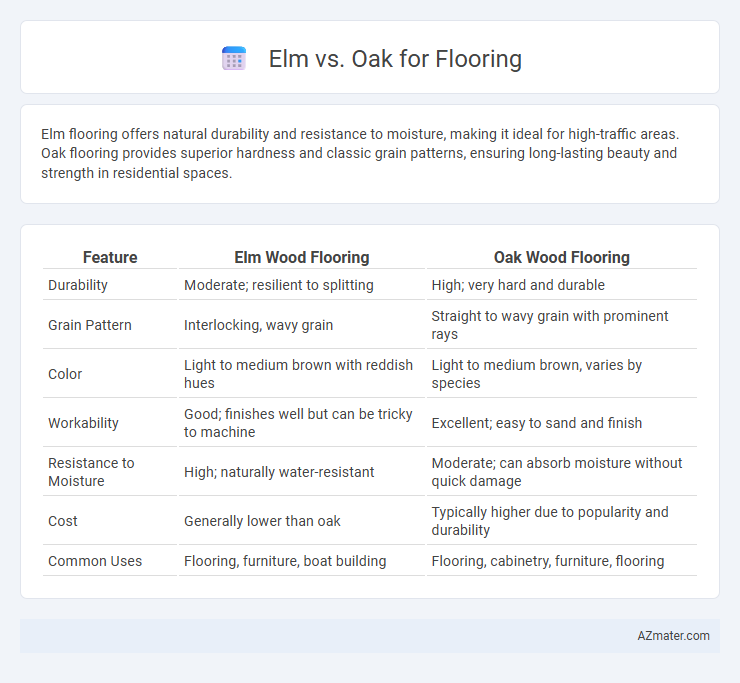Elm flooring offers natural durability and resistance to moisture, making it ideal for high-traffic areas. Oak flooring provides superior hardness and classic grain patterns, ensuring long-lasting beauty and strength in residential spaces.
Table of Comparison
| Feature | Elm Wood Flooring | Oak Wood Flooring |
|---|---|---|
| Durability | Moderate; resilient to splitting | High; very hard and durable |
| Grain Pattern | Interlocking, wavy grain | Straight to wavy grain with prominent rays |
| Color | Light to medium brown with reddish hues | Light to medium brown, varies by species |
| Workability | Good; finishes well but can be tricky to machine | Excellent; easy to sand and finish |
| Resistance to Moisture | High; naturally water-resistant | Moderate; can absorb moisture without quick damage |
| Cost | Generally lower than oak | Typically higher due to popularity and durability |
| Common Uses | Flooring, furniture, boat building | Flooring, cabinetry, furniture, flooring |
Introduction to Elm and Oak Flooring
Elm flooring offers a durable and visually appealing option characterized by its interlocking grain patterns and warm, reddish-brown tones that enhance rustic and traditional interiors. Oak flooring, known for its exceptional hardness and prominent grain, provides versatile design options ranging from classic to contemporary styles while ensuring long-lasting wear. Both hardwoods provide stable, resilient floors with unique aesthetic qualities suited for residential and commercial applications.
Wood Characteristics: Elm vs Oak
Elm wood offers a unique interlocking grain that provides excellent resistance to splitting and warping, making it suitable for fluctuating humidity environments. Oak features a prominent grain pattern with high density and hardness, contributing to exceptional durability and wear resistance ideal for high-traffic flooring. Both hardwoods present distinctive aesthetics and robust performance, with oak typically offering greater hardness and elm delivering superior shock resistance.
Durability and Hardness Comparison
Elm flooring exhibits moderate durability with a Janka hardness rating around 830, making it resistant to everyday wear but prone to dents under heavy impact. Oak flooring, particularly red oak, has a higher Janka hardness rating of approximately 1290, offering superior hardness that better withstands scratches, dents, and moisture. For long-lasting flooring in high-traffic areas, oak provides enhanced durability and hardness compared to elm, ensuring sustained performance over time.
Grain Patterns and Aesthetic Appeal
Elm flooring features interlocking grain patterns with striking, varied cathedrals and wavy lines, creating a lively, textured surface ideal for rustic and traditional interiors. Oak flooring offers a more consistent, pronounced grain with straight or slightly wavy patterns, delivering a classic, timeless aesthetic favored in contemporary and formal designs. Both woods provide durability and warmth, but elm's unique grain adds character while oak's uniformity enhances visual cohesion in flooring projects.
Installation Process Differences
Elm flooring typically requires more precise acclimation due to its higher moisture content, while oak is more stable and easier to install in varied environments. Oak's hardness allows for straightforward nailing or stapling, whereas elm's grain and flexibility often necessitate adhesive or floating installations to prevent splitting. These installation differences influence labor time and cost, with oak generally offering a faster and more cost-effective process.
Maintenance and Cleaning Requirements
Elm flooring requires regular sweeping and occasional damp mopping to maintain its natural finish, with a tendency to resist dirt but needing prompt attention to spills to prevent staining. Oak flooring boasts a durable surface that easily withstands frequent cleaning, benefiting from its dense grain which resists scratches and traps less dust, making it suitable for high-traffic areas. Both woods need periodic refinishing to preserve their appearance, but oak generally demands less intensive maintenance over time due to its hardness and stability.
Cost Analysis: Elm vs Oak Flooring
Elm flooring typically costs between $4 to $8 per square foot, making it a more budget-friendly option compared to oak, which ranges from $6 to $12 per square foot. The price difference reflects elm's relative abundance and faster growth rates, while oak's durability and popularity contribute to its higher cost. Homeowners seeking cost-effective flooring may prefer elm, whereas those prioritizing long-term value and premium aesthetics often invest in oak.
Environmental Impact and Sustainability
Elm flooring is valued for its durability and moderate environmental impact, as it often comes from sustainably managed forests with effective replanting practices. Oak, widely used in flooring, typically has a higher carbon footprint due to slower growth rates and more intensive harvesting processes, but it remains renewable when sourced from certified sustainably managed forests. Both woods contribute to eco-friendly flooring solutions when sustainably sourced, with certifications like FSC or PEFC playing a crucial role in ensuring responsible forest management.
Best Applications and Room Suitability
Elm flooring offers excellent durability and resistance to wear, making it ideal for high-traffic areas like hallways and living rooms, while its warm tones enhance traditional and rustic interiors. Oak is highly versatile and prized for its hardness and fine grain, making it suitable for almost any room, including kitchens and bedrooms, where both style and resilience are important. Both woods perform well with underfloor heating and can be finished in various stains, but oak's superior hardness makes it preferable for areas prone to heavy use and moisture exposure.
Pros and Cons: Elm vs Oak Flooring
Elm flooring offers excellent durability and a unique grain pattern that adds rustic charm, with higher resistance to splitting compared to oak. Oak flooring is known for its hardness, wear resistance, and classic appearance, providing a long-lasting surface ideal for high-traffic areas. However, elm can be more challenging to source sustainably and may require more frequent refinishing, while oak tends to be more readily available and easier to maintain over time.

Infographic: Elm vs Oak for Flooring
 azmater.com
azmater.com